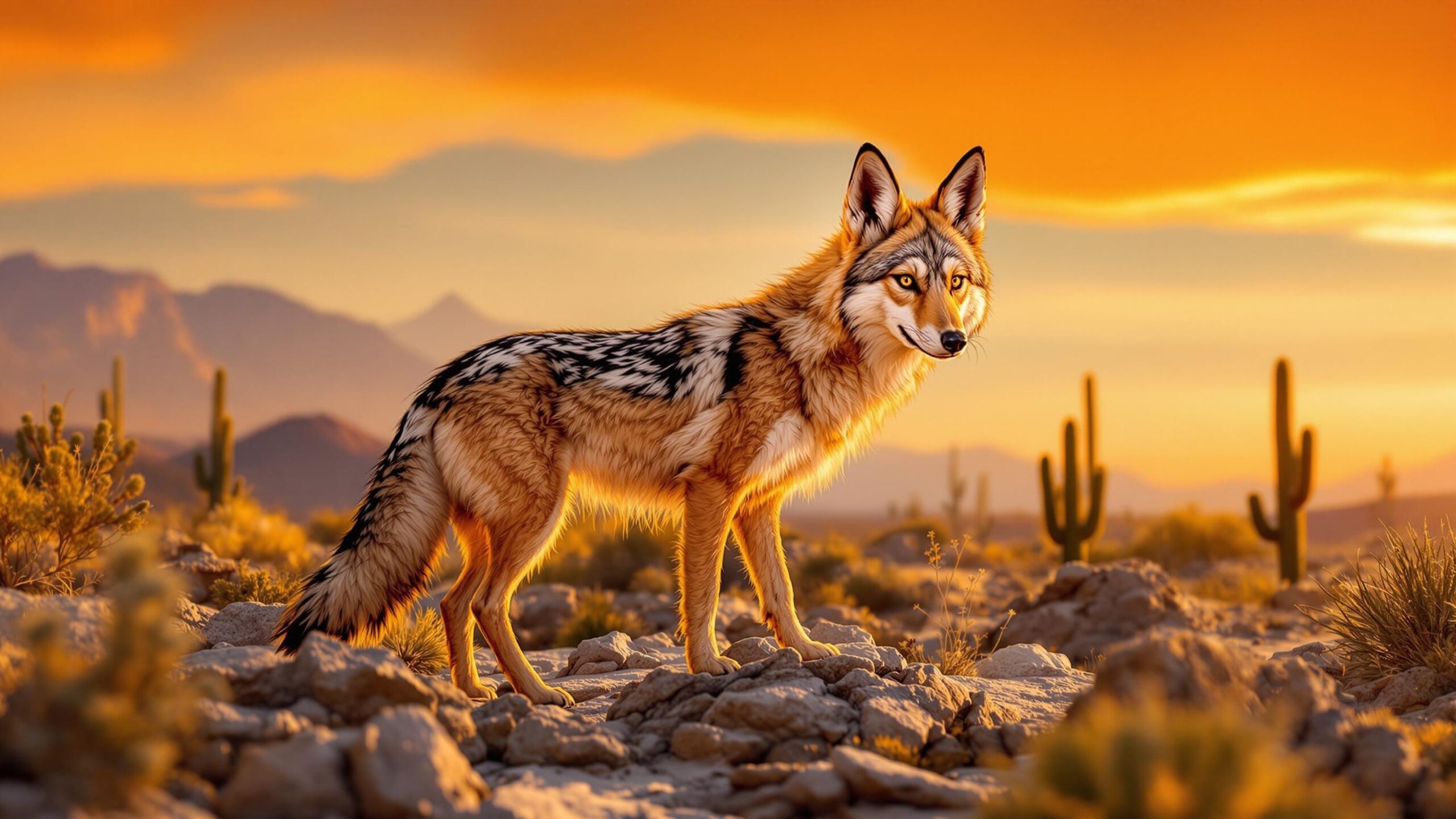Mexican Coyote: The Desert’s Clever Survivor
In the wild terrains of Mexico, from sun-scorched deserts to lush mountain forests, thrives one of North America’s most adaptable and cunning carnivores—the Mexican Coyote (Canis latrans cagottis). A subspecies of the broader coyote species (Canis latrans), the Mexican Coyote is a example of nature’s ingenuity, surviving and thriving in some of the most challenging and varied landscapes. Known for its intelligence, resourcefulness, and haunting nocturnal howls, this animal has captured the imaginations of local folklore, wildlife biologists, and nature lovers alike.
Although closely related to its northern cousins across the U.S. and Canada, the Mexican Coyote possesses unique characteristics shaped by its environment, making it an essential figure in Mexico’s ecological tapestry. Whether it’s navigating the volcanic slopes of the Sierra Madre or adapting to the outskirts of growing cities, the Mexican Coyote continues to defy expectations.
A Distinctive Member of the Coyote Clan
The Mexican Coyote is one of the many recognized subspecies of Canis latrans, and while it shares many traits with other coyotes, it stands apart in key ways. Slightly smaller and more slender than its northern counterparts, it typically weighs between 20 to 30 pounds. Its coat, often a blend of gray, brown, and buff tones, is suited for camouflage in arid and semi-arid regions. These coyotes exhibit seasonal variation in fur density, shedding heavily during warmer months and growing a denser coat in the colder seasons of the Mexican highlands.
Facially, the Mexican Coyote has a sharp muzzle, large ears, and eyes that exude both intelligence and wariness—hallmarks of a life spent dodging both predators and human threats. Its gait is fluid and efficient, making it capable of covering large territories quickly when searching for food or avoiding danger.
Habitat and Range: From Desert Sands to Forest Shadows
The Mexican Coyote is widely distributed throughout central and southern Mexico, although its range has been somewhat diminished due to urban expansion and habitat modification. This subspecies prefers open and semi-open landscapes, including grasslands, deserts, scrublands, and agricultural areas. However, it is also found in high-altitude forests and rocky foothills, showcasing its remarkable adaptability.
Some of the highest population densities are found in the Mexican Plateau and the Sierra Madre Oriental. The ability of the coyote to exploit fragmented and altered habitats gives it a survival edge, especially as other predators like the Mexican gray wolf face steeper conservation challenges. Coyotes have also expanded into suburban and peri-urban environments, scavenging food from garbage, farms, and even backyard compost piles, further illustrating their ecological plasticity.
Diet: Opportunistic and Omnivorous
Coyotes are opportunistic feeders, and the Mexican Coyote is no exception. It has a diverse diet that allows it to flourish in various ecosystems. As omnivores, they consume a wide variety of foods based on seasonal availability and habitat type. Their primary diet includes small mammals such as rabbits, rodents, and squirrels. Reptiles, amphibians, birds, and insects are also regularly consumed. In agricultural regions, they may feed on crops like corn, melons, and even fallen fruit. When available, carrion becomes an essential part of their diet, especially during dry seasons when live prey is harder to come by. Coyotes have also been observed hunting cooperatively in pairs or small family groups, especially when targeting larger prey like young deer or javelinas. This behavior reveals an underlying social structure that is more complex than often assumed. Still, most of their hunting is solitary, stealthy, and calculated.

Behavior and Communication: More Than Just a Howl
Mexican Coyotes are primarily nocturnal or crepuscular, meaning they are most active at dawn and dusk. However, in areas with minimal human disturbance, they may be active during the day as well. Despite their solitary reputation, coyotes often form close family units. These may include a mated pair and their offspring, working together to hunt and protect territory.
One of the most iconic aspects of coyote behavior is vocalization. The Mexican Coyote’s howls, yips, and barks serve as complex social signals used for communication across distances. These calls can signal territory boundaries, coordinate with pack members, or alert others to danger. The eerie, melodic howls echoing through a canyon or across a moonlit desert are a quintessential sound of the Mexican wilderness. Territorial marking is another vital behavior. Coyotes use scent marking—through urine and feces—to establish dominance and avoid unnecessary conflict with neighboring coyotes. This scent-based communication helps maintain population distribution in competitive landscapes.
Reproduction and Life Cycle
Mating typically occurs between January and March, with gestation lasting about 60 to 63 days. Mexican Coyotes are monogamous, forming stable pair bonds that can last multiple breeding seasons or even for life. The female gives birth to a litter of 4 to 7 pups in a den, which may be a hollowed-out burrow, a cave, or a sheltered area beneath tree roots or rock ledges.
Both parents are involved in raising the young, with the male often providing food while the female remains at the den. Pups begin emerging from the den at around 3 to 4 weeks old and are weaned by 8 to 10 weeks. By the time autumn arrives, many young coyotes disperse to find their own territory, although some may stay with the family unit into the following breeding season. Juvenile mortality can be high, especially in areas with human conflict, predators like pumas, or disease. However, the reproductive resilience of coyotes helps keep populations stable despite these challenges.
Cultural and Mythological Significance
The Mexican Coyote holds a prominent place in indigenous mythology and Mexican folklore. In many Mesoamerican cultures, the coyote was seen as a symbol of cunning, transformation, and survival. The Aztecs associated the coyote with the god Huehuecóyotl, a trickster deity known for shape-shifting and revelry. Stories often portrayed coyotes as clever creatures who used their wits to outsmart more powerful foes. In rural Mexican communities, the coyote continues to be both revered and reviled. While admired for its intelligence and tenacity, it is sometimes seen as a nuisance due to livestock predation or crop raiding. Nevertheless, its place in the cultural fabric remains deeply rooted, and its image frequently appears in art, music, and oral traditions.
Challenges and Threats in a Changing World
Despite its adaptability, the Mexican Coyote is not without threats. Habitat loss, vehicle collisions, poisoning, and illegal hunting continue to affect local populations. In areas where ranching is dominant, coyotes are often blamed for livestock deaths—sometimes unjustly—and are subject to eradication efforts, including poisoning campaigns that indiscriminately affect other wildlife.
Encroaching urbanization is a double-edged sword. While some coyotes adapt well to city fringes, others suffer from increased exposure to human conflict, domestic animals, and diseases such as mange, distemper, and rabies. Fragmented habitats can limit gene flow between populations, potentially reducing genetic diversity over time. On a broader scale, climate change may alter prey availability, water sources, and suitable denning habitats. Shifts in temperature and precipitation patterns could force coyotes to adjust their ranges or face increased competition with other carnivores.
Conservation Status and Perspectives
Currently, the Mexican Coyote is not considered endangered or under significant conservation concern, thanks to its high adaptability and broad range. It is listed as a subspecies of Least Concern under the broader coyote classification by the International Union for Conservation of Nature (IUCN). Nonetheless, regional conservationists emphasize the need for continued monitoring, particularly in rapidly developing areas where natural habitat is being lost.
Efforts to understand and mitigate human-coyote conflict are gaining ground in parts of Mexico. Education campaigns are encouraging local communities to use non-lethal deterrents, secure trash and livestock, and avoid feeding wildlife—actions that can reduce negative encounters. Ecologists are also calling for habitat corridors that allow safe movement between isolated populations, promoting genetic health and ecological resilience. The Mexican Coyote may not require emergency-level conservation, but it remains a barometer of ecosystem health. Its ability to coexist with people, adapt to change, and maintain ecological balance makes it a species worth protecting—if not through regulation, then through respect and informed coexistence.

Role in the Ecosystem
Coyotes play an essential ecological role as mid-level predators. They help regulate populations of rodents and other small animals, reducing crop pests and maintaining a natural balance in the food chain. Their scavenging behavior also aids in nutrient cycling, cleaning up carrion that could otherwise spread disease. In ecosystems where apex predators like wolves and jaguars have vanished or declined, coyotes often rise to fill ecological gaps, albeit in different ways. They are not top predators in the classic sense, but their presence influences the behaviors and populations of other animals, from mesopredators like foxes to prey species such as rabbits and voles. This trophic influence makes the Mexican Coyote a keystone species in many areas, subtly shaping the dynamics of life around it.
Urban Coyotes: A New Frontier
In recent years, Mexican Coyotes have expanded into urban and suburban zones, including the fringes of cities like Guadalajara, Mexico City, and Puebla. This urban colonization reflects their remarkable ability to adapt to novel conditions, but it also presents new challenges.
Urban coyotes tend to alter their behaviors to minimize human interaction. They become more nocturnal, shift den sites to quieter areas, and change diet to include human-related foods like garbage, pet food, or even small pets. These behaviors can lead to fear, misunderstanding, and conflict with local residents. Wildlife management experts emphasize coexistence strategies that promote public awareness and discourage behaviors that attract coyotes. Educating city dwellers about removing food sources, securing pets, and reporting sightings responsibly is key to a sustainable balance between humans and urban coyotes.
A Future Written in Adaptation
The Mexican Coyote is a survivor, a shape-shifter, and a storyteller. From ancient myths to modern suburbs, its journey is one of perseverance and clever evolution. While it may lack the majestic grandeur of the jaguar or the mystique of the gray wolf, it represents something equally compelling—the ability to survive by adapting without losing one’s identity. In the face of a rapidly changing world, the Mexican Coyote will likely continue to evolve, finding new ways to coexist with people and nature. Its story is far from over, and in many ways, it is just beginning.

